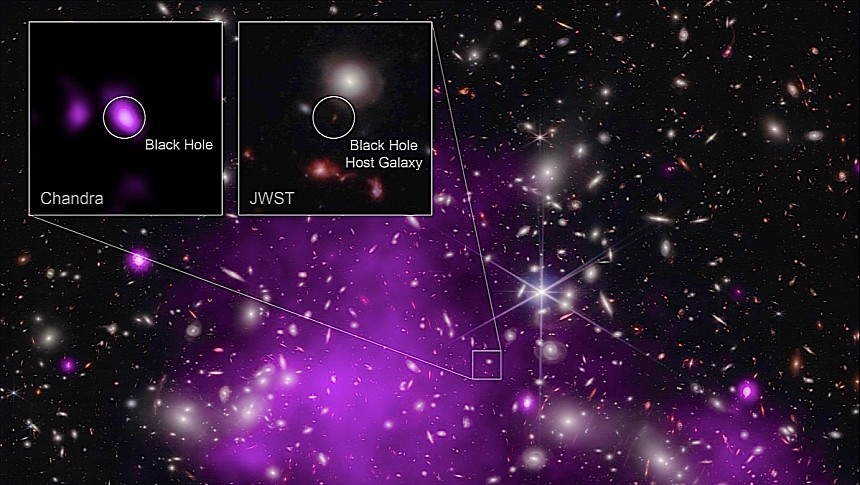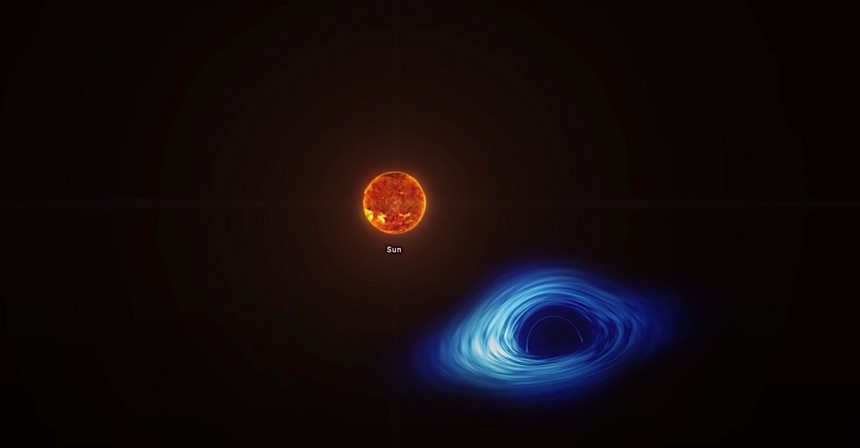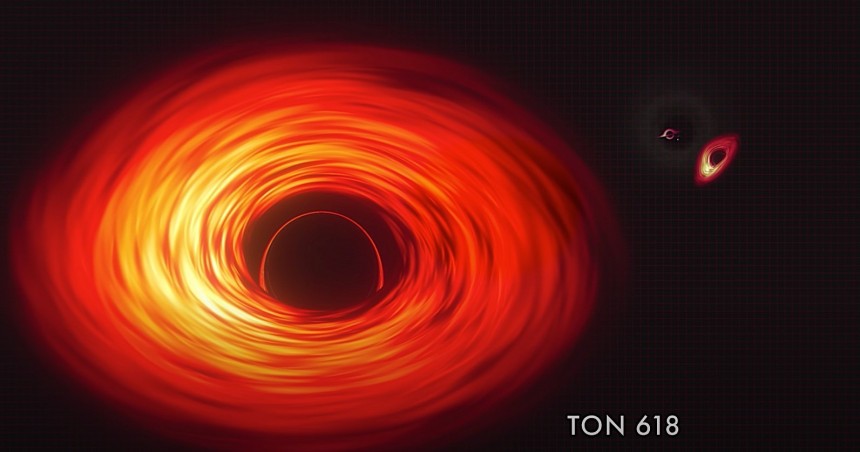Earlier this week the American Space Agency made an announcement that stunned astronomers. A team led by a researcher from the Center for Astrophysics at Harvard & Smithsonian had discovered a record-breaking black hole. This is our deep dive right into it.
We'll start with the basics and remind you what a black hole is, or at least what we think it is: as NASA defines it, a space object "with a gravitational pull so strong that nothing, not even light, can escape it."
It's not a planet, nor an asteroid, but a region of spacetime that swallows everything around it, matter or radiation, and never lets it go. It's a simplistic definition, but it's the best humanity can do when it comes to these mysterious things.
We don't know for sure what happens to the stuff falling in, nor what lies beyond a black hole's surface (the event horizon). We do know however that almost every galaxy out there has at least one of them, with many of their respective stars spinning around it just like planets spin around Suns.
Our own Milky Way, for instance, has a black hole. It's called Sagittarius A, and it's located more than 25,000 light years from Earth – too far to have any direct effect on us.
Sagittarius A is a supermassive black hole, the largest kind there is. It is 4.3 million times larger than the Sun in terms of mass, and in terms of size it would be enough to fill half of Mercury's orbit in the solar system.
But what if I told you that's tiny compared to the black hole whose existence NASA just announced? What if I told you the thing has a mass of anywhere between ten million and 100 million Suns? What if I told you its mass equals that of all the stars in the galaxy it lives in (whereas, generally, black holes have just about ten percent)?
All unbelievable numbers in the above paragraph are real, and have been deduced by the team of astronomers after they've looked at data obtained by two of our species' most impressive telescopes: the Chandra X-ray Observatory and the James Webb.
The former tool was used to pinpoint the black hole in the galaxy Webb discovered. And it was worth the effort, as the thing has now become the "most distant black hole yet seen in X-rays."
How distant? Well, consider the fact that the hints of the black hole we're receiving now (as you can't actually see one) date back to just 470 million years after the Big Bang. That's from about 13.4 billion years ago!
The galaxy where the black hole resides is called UHZ1 and can be found in the sky as you look toward galaxy cluster Abell 2744. It's 13.2 billion light-years from Earth, and we see it as it was when the Universe was just three percent of its current age.
As we perceive it now, the black hole is still in its relative infancy, thus growing. It's a stage of development for such objects we humans have never experienced before, when the mass of the hole is about the same as the galaxy that supports it.
The fact this incredible object was pinpointed so far away from us has immense implications for the people looking at the sky for a living. Whatever things the UHZ1 reveals about itself, it will help us at least to some degree understand how the Universe's first supermassive black holes came to be.
For this particular one the theory is the black hole of UHZ1 was born this big, thanks to the collapse of a cloud of gas of impossible-to-describe dimensions. That's probably the only way it could have reached this size so soon after the Big Bang.
That's one of the current theories explaining the birth of supermassive black holes, the other being the explosion of the Universe's first stars which result in smaller black holes that later begin to grow.
Priyamvada Natarajan of Yale University, one of the researchers behind this finding, says this might very well be "the first detection of an 'Outsize Black Hole' and the best evidence yet obtained that some black holes form from massive clouds of gas."
"For the first time we are seeing a brief stage where a supermassive black hole weighs about as much as the stars in its galaxy before it falls behind," the researcher added in a statement.
For those of you who would like a more technical look at how the discovery was possible, the discovery of the UHZ1 black hole will forever be written in the journal Nature Astronomy, where the paper on this topic was published.
With tons of data left to study from both Webb and Chandra it's probably only a matter of time until history is rewritten once again. So we should all brace ourselves for what may very well be a major shift in our understanding of the Universe.
It's not a planet, nor an asteroid, but a region of spacetime that swallows everything around it, matter or radiation, and never lets it go. It's a simplistic definition, but it's the best humanity can do when it comes to these mysterious things.
We don't know for sure what happens to the stuff falling in, nor what lies beyond a black hole's surface (the event horizon). We do know however that almost every galaxy out there has at least one of them, with many of their respective stars spinning around it just like planets spin around Suns.
Our own Milky Way, for instance, has a black hole. It's called Sagittarius A, and it's located more than 25,000 light years from Earth – too far to have any direct effect on us.
Sagittarius A is a supermassive black hole, the largest kind there is. It is 4.3 million times larger than the Sun in terms of mass, and in terms of size it would be enough to fill half of Mercury's orbit in the solar system.
But what if I told you that's tiny compared to the black hole whose existence NASA just announced? What if I told you the thing has a mass of anywhere between ten million and 100 million Suns? What if I told you its mass equals that of all the stars in the galaxy it lives in (whereas, generally, black holes have just about ten percent)?
The former tool was used to pinpoint the black hole in the galaxy Webb discovered. And it was worth the effort, as the thing has now become the "most distant black hole yet seen in X-rays."
How distant? Well, consider the fact that the hints of the black hole we're receiving now (as you can't actually see one) date back to just 470 million years after the Big Bang. That's from about 13.4 billion years ago!
The galaxy where the black hole resides is called UHZ1 and can be found in the sky as you look toward galaxy cluster Abell 2744. It's 13.2 billion light-years from Earth, and we see it as it was when the Universe was just three percent of its current age.
As we perceive it now, the black hole is still in its relative infancy, thus growing. It's a stage of development for such objects we humans have never experienced before, when the mass of the hole is about the same as the galaxy that supports it.
The fact this incredible object was pinpointed so far away from us has immense implications for the people looking at the sky for a living. Whatever things the UHZ1 reveals about itself, it will help us at least to some degree understand how the Universe's first supermassive black holes came to be.
That's one of the current theories explaining the birth of supermassive black holes, the other being the explosion of the Universe's first stars which result in smaller black holes that later begin to grow.
Priyamvada Natarajan of Yale University, one of the researchers behind this finding, says this might very well be "the first detection of an 'Outsize Black Hole' and the best evidence yet obtained that some black holes form from massive clouds of gas."
"For the first time we are seeing a brief stage where a supermassive black hole weighs about as much as the stars in its galaxy before it falls behind," the researcher added in a statement.
For those of you who would like a more technical look at how the discovery was possible, the discovery of the UHZ1 black hole will forever be written in the journal Nature Astronomy, where the paper on this topic was published.
With tons of data left to study from both Webb and Chandra it's probably only a matter of time until history is rewritten once again. So we should all brace ourselves for what may very well be a major shift in our understanding of the Universe.












